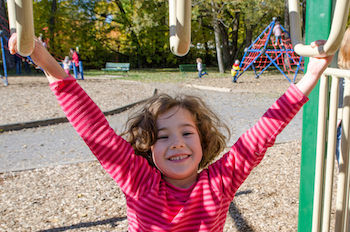The Centers for Disease Control recommend at least 60 minutes of exercise a day for children and adolescents. A 2013 policy statement from the American Academy of Pediatrics stated that recess should not be withheld for any reason. However, many states have no physical activity requirement and no policy recommending recess or physical activity breaks.
Earlier this year, the Virginia State Legislature passed a new state law that requires:
- K-5 students complete at least 20 minutes of physical activity a day or an average of 100 minutes per week
- 6-12 students complete at least 150 minutes of exercise a week.
I talked to Susan Cluett, UVA Children’s Fitness Clinic program director, about the importance of exercise during the school day and what happens when school-aged kids don’t get enough exercise.
Kids, Exercise and UVA Children’s Fitness Clinic
Why do you think that kids aren’t getting enough exercise in schools?
There are a lot of reasons, like schools eliminating or reducing PE or recess in favor of instruction time. Withholding recess as a punishment is common in a lot of schools, like if a kid misbehaves or forgets to do homework, recess is taken away. Recess should be part of a normal school day, and it should never be withheld. The kids who disrupt class are the kids who need exercise the most.
Is your child overweight or obese? Contact the UVA Children’s Fitness Clinic.
What kinds of patients are referred to you at the Children’s Fitness Clinic?
The child’s pediatrician or primary care physician refers them to us. The criteria for the Children’s Fitness Clinic is:
- Having a body mass index (BMI) surpassing the 85th percentile
- Rapid weight gain
- Insulin resistance
- Hyperlipidemia (an abnormally high concentration of fats in the blood)
- Hypertension (high blood pressure)
Our patients are between the ages of six months and 21 years.
We have kids as young as nine who have polycystic ovarian syndrome (PCOS). Some may have impaired glucose, metabolic syndrome, depression and low self-esteem. We also have some patients who are at risk for Type 2 diabetes, but they are not the focus of the clinic.

How much does exercise factor into treating these conditions?
Both nutrition and exercise are essential in treating these conditions. Some parents tell us at our initial intake meeting that their child has asthma, but in many cases it’s a case of deconditioning, or being out of shape.
With consistent exercise, their symptoms can reverse. Exercise makes the body more responsive to insulin, so children with metabolic syndrome or insulin resistance can see a great deal of improvement in a period of six weeks with 10-20 minutes of strenuous exercise a day.
Many of our patients turned to food after experiencing abuse and trauma. Exercise releases endorphins and can improve some symptoms of depression as part of a wider treatment program with counseling, nutrition and behavior modification.
How does having exercise at school impact your patients?
For a lot of children, school provides structure. That goes for meals and exercise. On average, our patients gain seven pounds over the course of the summer vacation. That’s a lot of weight for an adult, let alone a child. Work schedules, finances and safety sometimes mean that kids are at home, indoors, with no scheduled mealtimes or regular exercise for a lot of their vacation time.
It’s not just one factor, but scheduled exercise and scheduled mealtimes have a positive impact on children who are overweight.
What do you think of the new law in Virginia (which goes into effect during the 2018-2019 school year)?
I think it’s great. Children need to play! It improves executive function and helps the kids who have behavior issues. It lets kids exercise in their environment. So many kids don’t live in places where it’s safe to walk home or play outdoors, and many more don’t have the resources for joining sports teams or a gym.
Exercise at school, whether it’s free play at recess or physical education, is a huge part of children’s fitness. Exercise is an essential part of the school day.


I hate this article all people want these days is to be fat and eat doughnuts reading this article affends me so much.